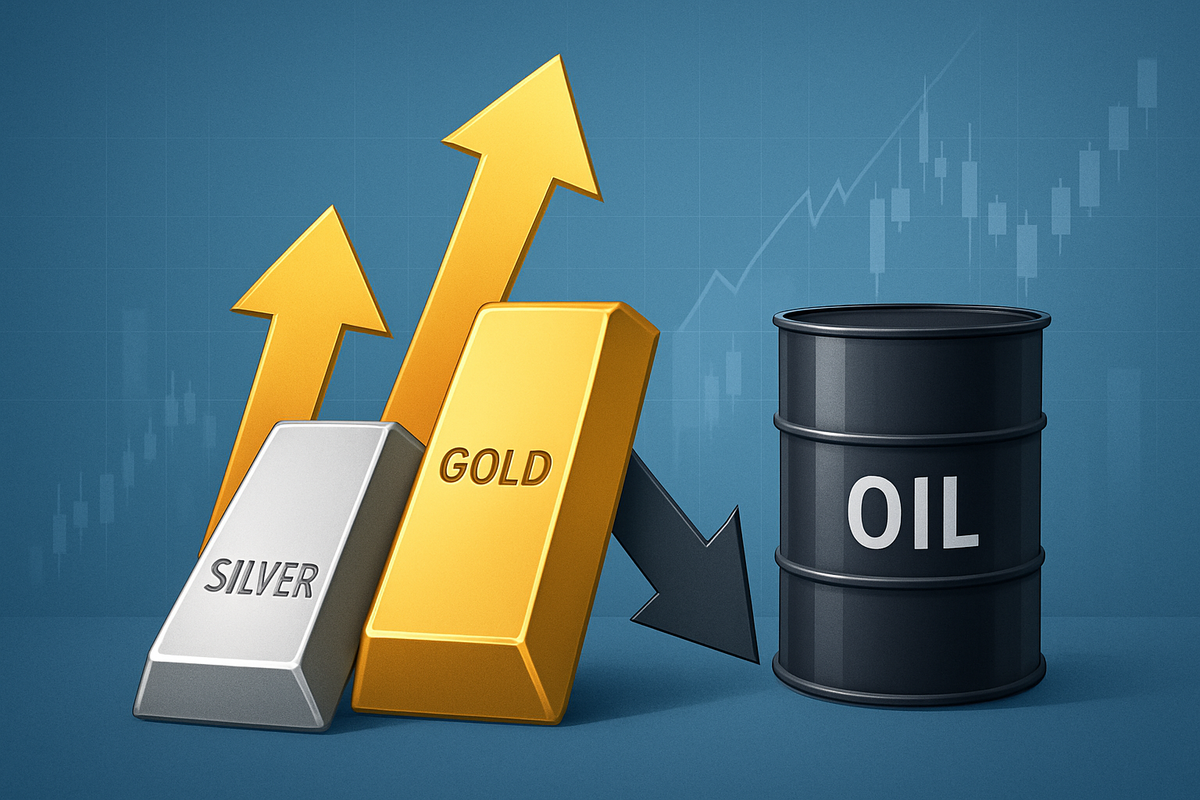
In a dramatic display of market strength, silver has surged to unprecedented levels, spearheading a significant rally across precious metals that sees gold also climbing robustly. As of November 13, 2025, the white metal has shattered previous records, reflecting a powerful confluence of escalating industrial demand, persistent supply deficits, and a renewed safe-haven appeal. This monumental ascent signals a profound shift within the broader commodities landscape, even as crude oil prices experience a notable decline, highlighting a selective but potent bullish trend in the metals sector.
The immediate implications of silver's rally are far-reaching, signaling a potential recalibration of investment strategies and a re-evaluation of its intrinsic value. Investors are flocking to precious metals, driven by macroeconomic uncertainties and a search for tangible assets, while industrial sectors reliant on silver face burgeoning costs. This divergence from the struggling energy market underscores a complex and nuanced environment, where traditional commodity correlations are being tested, and the enduring allure of precious metals as both a monetary and industrial asset is undeniably reaffirmed.
Silver's Meteoric Rise: A Detailed Account of the Rally
The year 2025 has been nothing short of spectacular for silver, culminating in its breathtaking surge to new all-time highs on November 13. The COMEX December silver contract touched an astounding $54.42 per ounce, while spot silver retested its October 2025 peak of $54.49, marking a decisive breakthrough from a decade-long consolidation period. This monumental achievement is underpinned by a staggering year-to-date gain of over 74%, with the metal advancing more than 21% in the last 30 days alone, and a sharp 11% increase in the five days leading up to its record-breaking performance.
Several critical factors have converged to fuel this extraordinary rally. Industrial demand for silver has proven insatiable, driven by its indispensable role in the rapidly expanding sectors of electronics, solar panels, batteries, and the burgeoning infrastructure required for artificial intelligence. Massive investments in AI-related data centers and power systems have significantly amplified the need for silver, creating a structural demand imbalance. This robust industrial appetite is compounded by persistent supply shortages; global mine production has struggled to keep pace, with London's LBMA data revealing declining vault inventories and COMEX warehouses showing no meaningful accumulation of deliverable stock. Furthermore, surging physical demand from India, the world's largest consumer, particularly during the Diwali festival season, has seen imports double this year, exacerbating the scarcity.
Adding to its upward momentum is silver's re-emergence as a premier safe-haven asset. Expectations of Federal Reserve interest rate cuts, coupled with a weaker U.S. dollar and broader economic uncertainties, have significantly heightened investor interest in non-interest-bearing precious metals. The anticipated release of economic data following the reopening of the U.S. government on November 13 is expected to further bolster rate cut expectations. Moreover, central banks, including sovereign wealth funds in Russia, India, and Saudi Arabia, are increasingly recognizing silver as monetary insurance alongside gold, actively accumulating reserves and providing a strong fundamental underpin to its value.
Concurrently, gold has also demonstrated formidable strength, trading above $4,100 per ounce on November 12-13, 2025, and nearing its October 2025 all-time high of $4,400. On November 10, gold hit a record high of approximately $4,110 per ounce, climbing over 50% year-to-date in 2025. The yellow metal shares many of silver's drivers, including heightened safe-haven demand amidst geopolitical tensions and fears of economic slowdown, significant central bank buying, and its traditional role as an inflation hedge against persistent fiscal irresponsibility and global monetary expansion. The U.S. Federal Reserve's signals towards "ample" liquidity bond buying, perceived by many as "stealth quantitative easing," provides a strong fundamental backdrop for sustained upward trends in both precious metals.
In stark contrast to the precious metals, crude oil prices have faced significant downward pressure. On November 13, 2025, WTI crude oil futures plummeted over 4% to approximately $58.42 per barrel, reaching a three-week low, while Brent crude traded around $63.14 per barrel. This decline is primarily attributed to oversupply fears, with industry data indicating rising U.S. crude inventories and warnings from the International Energy Agency (IEA) and OPEC of an increasingly unbalanced market with a growing surplus. This sharp divergence underscores a unique and selective rally concentrated within the precious metals sector.
Corporate Fortunes: Winners and Losers in the Commodity Shake-Up
The monumental rally in silver and gold, juxtaposed with declining oil prices, will undoubtedly create a distinct landscape of winners and losers across various industries and public companies.
Potential Winners:
- Precious Metal Mining Companies: Companies like Pan American Silver Corp. (NASDAQ: PAAS), Fresnillo PLC (LSE: FRES), and Wheaton Precious Metals Corp. (NYSE: WPM) are direct beneficiaries. Higher silver and gold prices translate directly into increased revenues and potentially expanded profit margins. Their stock prices are likely to reflect this positive sentiment, attracting significant investor interest. Exploration and development companies in this space may also see renewed funding opportunities.
- Gold Mining Companies: Major gold producers such as Barrick Gold Corporation (NYSE: GOLD) and Newmont Corporation (NYSE: NEM) will see substantial boosts from gold's strong performance. Their profitability will be enhanced, and they may use this period of high prices to strengthen their balance sheets, increase dividends, or pursue strategic acquisitions.
- Precious Metals ETFs and Investment Funds: Exchange-Traded Funds (ETFs) like the iShares Silver Trust (NYSEARCA: SLV) and SPDR Gold Shares (NYSEARCA: GLD) will experience increased inflows and asset appreciation as investors seek direct exposure to the rallying metals. Investment firms specializing in commodity funds will also see their portfolios perform exceptionally well.
- Companies with Significant Silver Reserves: Even companies not primarily focused on silver mining but holding substantial silver reserves as by-products of other metal extractions (e.g., copper, lead, zinc) will see an uplift in the value of their assets.
Potential Losers/Challengers:
- Solar Panel Manufacturers: Silver is a critical component in photovoltaic cells. Companies like First Solar, Inc. (NASDAQ: FSLR) and other solar panel producers will face higher raw material costs, which could squeeze profit margins or necessitate price increases for their products, potentially impacting demand.
- Electronics Manufacturers: The electronics industry is a massive consumer of silver in components like switches, contacts, and conductors. Tech giants such as Apple Inc. (NASDAQ: AAPL), Samsung Electronics Co., Ltd. (KRX: 005930), and other hardware manufacturers will see their input costs rise. While large companies might absorb some of these costs, smaller players could be more significantly impacted.
- Automotive Industry: Silver is used in various automotive applications, especially in electric vehicles (EVs) due to its conductivity. Automakers like Tesla, Inc. (NASDAQ: TSLA), General Motors Company (NYSE: GM), and Ford Motor Company (NYSE: F) might experience increased production costs, particularly as EV adoption continues to grow, demanding more silver per vehicle.
- Oil and Gas Companies: The declining oil prices will negatively impact the profitability of oil and gas producers such as Exxon Mobil Corporation (NYSE: XOM), Chevron Corporation (NYSE: CVX), and BP p.l.c. (LSE: BP). Lower crude prices reduce revenue per barrel, potentially leading to reduced capital expenditure, layoffs, or a slowdown in exploration activities.
The contrasting fortunes underscore the importance of diversified portfolios and strategic hedging in a commodity market characterized by such pronounced divergences.
Wider Significance: A New Era for Commodities?
The current silver-led commodity rally, occurring simultaneously with a robust gold market and a declining oil sector, signifies a potentially new era for the broader commodities market. This event is not merely an isolated price spike but rather fits into broader industry trends emphasizing the unique roles of precious metals in a global economy grappling with inflation, geopolitical instability, and a massive technological transition. The decoupling of precious metals from traditional energy commodities suggests a re-evaluation of fundamental drivers for different asset classes.
Historically, major commodity rallies have often been broad-based, driven by synchronized global economic growth or widespread inflationary pressures. However, this current rally appears more selective, largely concentrated in precious metals due to their dual function as safe-haven assets and critical industrial inputs. The robust demand from sectors like AI infrastructure and solar energy for silver highlights a structural shift, where the physical properties of certain metals are becoming increasingly indispensable. This trend suggests that industrial metals with technological applications, especially those with supply constraints, may continue to outperform traditional energy commodities, which are more susceptible to oversupply and demand fluctuations.
The ripple effects on competitors and partners are significant. For instance, companies that have invested heavily in green technologies, such as solar power, will face increased raw material costs, potentially impacting their competitive edge or requiring them to innovate in material usage. Conversely, entities involved in recycling precious metals may see increased profitability. Regulatory and policy implications could also emerge, particularly if the rally continues to drive up costs for critical industries. Governments might explore strategies to secure domestic supplies of strategic metals or incentivize research into alternative materials, though silver's unique properties make direct substitution challenging.
Comparing this event to historical precedents reveals both similarities and differences. The early 2011 silver spike, for example, was largely driven by speculative fervor and a weaker dollar. While a weaker dollar and monetary policy expectations are present now, the current rally appears to have a stronger fundamental underpinning from industrial demand and persistent supply deficits. This suggests a more sustainable, albeit potentially volatile, upward trajectory for silver. The central bank accumulation of gold and silver also echoes historical periods when precious metals were seen as crucial sovereign assets, further solidifying their role in the global financial system.
What Comes Next: Navigating a Dynamic Market
Looking ahead, the trajectory of the silver and gold rally, and indeed the broader commodities market, will be shaped by a complex interplay of economic, technological, and geopolitical factors. In the short term, the momentum behind silver and gold is likely to persist, driven by continued industrial demand, safe-haven buying, and expectations of accommodating monetary policies from central banks, particularly the Federal Reserve. Any further weakening of the U.S. dollar or escalation of global uncertainties could provide additional tailwinds. However, investors should be mindful of potential profit-taking and technical corrections, especially after such a rapid ascent.
In the long term, the structural supply deficits in silver, coupled with its increasing utility in advanced technologies, suggest a sustained period of elevated prices. The ongoing build-out of AI infrastructure, the expansion of renewable energy capacity, and the electrification of transportation will continue to drive demand for silver, making it a critical strategic metal. Gold, meanwhile, is expected to maintain its role as a hedge against inflation and geopolitical risks, with central bank buying providing a consistent floor to its price.
Potential strategic pivots or adaptations required for companies include a renewed focus on supply chain resilience for industrial users of silver, exploring long-term contracts, or investing in recycling technologies. Mining companies might accelerate exploration and development projects to capitalize on higher prices, but they must also manage rising operational costs and environmental considerations. Market opportunities will emerge in the form of increased investment in precious metals mining, refining, and related services, as well as in companies developing innovative ways to use or conserve silver.
Several scenarios could unfold. A continued strong global economic recovery, particularly in manufacturing, could further boost industrial demand for silver. Conversely, a significant global economic downturn could dampen industrial demand but simultaneously amplify safe-haven flows into both silver and gold. A more aggressive tightening of monetary policy by the Federal Reserve, contrary to current expectations, could present a headwind for non-yielding assets like precious metals. However, given the current macroeconomic environment, the path of least resistance for precious metals appears to be upward, albeit with inherent volatility.
Comprehensive Wrap-Up: A Reshaped Commodity Landscape
The silver-led commodity rally to record highs on November 13, 2025, represents a pivotal moment in the financial markets, underscoring a significant reshaping of the commodity landscape. The key takeaway is the profound divergence between precious metals, particularly silver and gold, and traditional energy commodities like oil. Silver's extraordinary 74% year-to-date climb is a testament to its dual strength as an indispensable industrial metal, crucial for the burgeoning tech and green energy sectors, and a resilient safe-haven asset in an era of economic uncertainty and accommodative monetary policies.
Moving forward, the market is likely to remain characterized by this selective strength. The structural supply deficits in silver, combined with relentless demand from AI, solar, and electronics industries, suggest that its elevated price levels may be more sustainable than previous speculative bubbles. Gold's consistent performance, bolstered by central bank accumulation and its role as an inflation hedge, further solidifies the bullish outlook for precious metals. The decline in oil prices, driven by oversupply concerns, highlights that not all commodities will benefit from the same macroeconomic forces, emphasizing the importance of granular analysis.
Investors should watch for several key indicators in the coming months. These include further pronouncements from the Federal Reserve regarding interest rates and liquidity, global economic growth data, particularly manufacturing PMIs that indicate industrial demand, and geopolitical developments that could fuel safe-haven buying. Additionally, monitoring inventory levels at COMEX and LBMA, as well as physical demand trends from major consumers like India, will provide crucial insights into the supply-demand balance for silver. The performance of precious metal mining stocks and related ETFs will also serve as a barometer for market sentiment.
This event marks a clear shift, positioning silver not just as a precious metal, but as a strategic commodity vital for the future of technology and energy. Its lasting impact will likely be a re-evaluation of its intrinsic value and a recognition of its critical role in the global economy, making it a compelling asset for investors navigating an increasingly complex and dynamic market.
This content is intended for informational purposes only and is not financial advice





